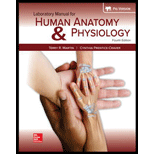
Concept explainers
Which of the following membrane movements is not a passive process?
- osmosis
- diffusion
- active transport
- filtration
Introduction:
Passive transportation is a method in which the movement of the cellular substances takes place from one cell to another. Energy is not required in the transport of molecules.
Answer to Problem 1PL
Correct answer:
The correct answer is option (c) active transport.
Explanation of Solution
Explanation/justification for the correct answer:
Option (c) active transport. Active transportation is the passage of molecules from cell to cell. It requires energy for the process of transport as the movement is initiated against the concentration gradient. So, the correct answer is option (c).
Explanation for incorrect answer:
Option (a) osmosis. Osmosis is a process of movement of water molecules from low concentration to a high concentration. It requires no energy for the process of transport. So, this is an incorrect option.
Option (b) diffusion. Diffusion is a process of movement of molecules, ions, and atoms from high concentration to low concentration. It occurs in the absence of energy. So, this is an incorrect option.
Option (d) filtration. Filtration is a process of movement of solute or fluid against the gradient. The process of filtration occurs by applying the pressure, which can result in the movement of the molecules against the gradient. It does not require energy and filter across the semi-permeable membrane. So, this is an incorrect option.
Want to see more full solutions like this?
Chapter 6 Solutions
Laboratory Manual For Human Anatomy & Physiology
- State the five functions of Globular Proteins, and give an example of a protein for each function.arrow_forwardDiagram of check cell under low power and high powerarrow_forwarda couple in which the father has the a blood type and the mother has the o blood type produce an offspring with the o blood type, how does this happen? how could two functionally O parents produce an offspring that has the a blood type?arrow_forward
- What is the opening indicated by the pointer? (leaf x.s.) stomate guard cell lenticel intercellular space none of thesearrow_forwardIdentify the indicated tissue? (stem x.s.) parenchyma collenchyma sclerenchyma ○ xylem ○ phloem none of thesearrow_forwardWhere did this structure originate from? (Salix branch root) epidermis cortex endodermis pericycle vascular cylinderarrow_forward
- Identify the indicated tissue. (Tilia stem x.s.) parenchyma collenchyma sclerenchyma xylem phloem none of thesearrow_forwardIdentify the indicated structure. (Cucurbita stem l.s.) pit lenticel stomate tendril none of thesearrow_forwardIdentify the specific cell? (Zebrina leaf peel) vessel element sieve element companion cell tracheid guard cell subsidiary cell none of thesearrow_forward
- What type of cells flank the opening on either side? (leaf x.s.) vessel elements sieve elements companion cells tracheids guard cells none of thesearrow_forwardWhat specific cell is indicated. (Cucurbita stem I.s.) vessel element sieve element O companion cell tracheid guard cell none of thesearrow_forwardWhat specific cell is indicated? (Aristolochia stem x.s.) vessel element sieve element ○ companion cell O O O O O tracheid O guard cell none of thesearrow_forward
 Human Biology (MindTap Course List)BiologyISBN:9781305112100Author:Cecie Starr, Beverly McMillanPublisher:Cengage Learning
Human Biology (MindTap Course List)BiologyISBN:9781305112100Author:Cecie Starr, Beverly McMillanPublisher:Cengage Learning Biology Today and Tomorrow without Physiology (Mi...BiologyISBN:9781305117396Author:Cecie Starr, Christine Evers, Lisa StarrPublisher:Cengage Learning
Biology Today and Tomorrow without Physiology (Mi...BiologyISBN:9781305117396Author:Cecie Starr, Christine Evers, Lisa StarrPublisher:Cengage Learning Human Physiology: From Cells to Systems (MindTap ...BiologyISBN:9781285866932Author:Lauralee SherwoodPublisher:Cengage Learning
Human Physiology: From Cells to Systems (MindTap ...BiologyISBN:9781285866932Author:Lauralee SherwoodPublisher:Cengage Learning Concepts of BiologyBiologyISBN:9781938168116Author:Samantha Fowler, Rebecca Roush, James WisePublisher:OpenStax College
Concepts of BiologyBiologyISBN:9781938168116Author:Samantha Fowler, Rebecca Roush, James WisePublisher:OpenStax College





